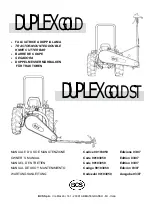
Maintenance, Service, and Repair
Motor Service
Page 3
3. Measure the commutator undercut depth in 5-
places around the commutator.
• If any one of the measurements is less than the
minimum undercut depth specified in
Service
Limits
at the end of this section, then the
commutator must be undercut. Refer to
Repair
Commutator
section for information regarding
undercutting the commutator.
4. Inspect the commutator for groves.
• If the commutator is grooved then it must be
machined on a lathe. Do not machine the
commutator past the minimum diameter
specified in
Service Limits
section. Refer to
Repair Commutator
section for information
regarding machining the commutator.
5. Inspect the commutator for burn marks.
• Burn marks and/or raised commutator segments
90 or 180 degrees apart is evidence of a shorted
armature. A tool called a growler is required to
reliably test for a shorted armature.
6. Inspect the commutator for raised segments.
Raised segments could be a result of a stalled
motor or shorted armature. A tool called a growler
is required to reliably test for a shorted armature.
• If the armature is not shorted then the raised
segments can be removed by machining the
commutator. Do not machine the commutator
past the minimum diameter specified in
Service Limits
section. Refer to
Repair
Commutator
section for information regarding
machining the commutator.
7. Visually inspect the armature windings for burnt
insulation. Burnt insulation is a direct result of
motor overheating and could lead to a shorted
armature.
• If the insulation is cracked or burnt, then it is
recommend that the armature or motor be
replaced.
NOTE: If the armature has been burnt then there is a
good possibility that the field windings may
also be burnt. Symptoms indicating a shorted
field include high motor current, lack of power
and possibly excessive speed.
8. Using a growler, test the armature for shorts.
• If the armature is shorted, then we recommend
that the armature or motor be replaced.
9. Using the continuity function of digital multi meter,
check the continuity around the entire commutator
by placing one test lead against one of the
commutator segments and the other test lead
against all of the other segments one at a time.
There should be continuity around the entire
commutator. If any segment indicates an open
circuit, then the motor must be replaced.
10. Using the continuity function of digital multi meter,
check the continuity from any one of the
commutator segments and the armature frame. If
it is not an open circuit, then the armature is
shorted and the motor must be replaced.
11. Measure the armature and field resistance (refer
to
Service Limits
table at end of this section). If
the armature of field resistance is not within
specification then the motor must be repaired or
replaced.
Typical burn mark on a shorted armature
Summary of Contents for TT-316-36
Page 2: ......
Page 6: ...TAYLOR DUNN...
Page 12: ...TAYLOR DUNN...
Page 28: ...TAYLOR DUNN...
Page 76: ...TAYLOR DUNN...
Page 82: ...TAYLOR DUNN...
Page 96: ...TAYLOR DUNN...
Page 99: ...Sevcon Troubleshooting Page 3 Electrical Troubleshooting Identifying Your Controller...
Page 120: ...TAYLOR DUNN...
Page 134: ...TAYLOR DUNN...
Page 138: ...Illustrated Parts Page 2 Front Fork...
Page 140: ...Illustrated Parts Page 4 Front Brakes...
Page 142: ...Illustrated Parts Page 6 Tilt Steering Column and Gear...
Page 146: ...Illustrated Parts Page 10 Transmission Differential Case Rear Axle...
Page 148: ...Illustrated Parts Page 12 Rear Brakes Master Cylinder 8 Brake Body...
Page 150: ...Illustrated Parts Page 14 Rear Suspension...
Page 152: ...Illustrated Parts Page 16 Motor...
Page 156: ...Illustrated Parts Page 20 Brake Lines...
Page 158: ...Illustrated Parts Page 22 Wheels and Tires Ref wheel hub 1 2 5 assembly 4 3 6 7 8 9 10...
Page 164: ...Illustrated Parts Page 28 Miscellaneous Frame and Body...
Page 168: ...Illustrated Parts Page 32 Decals...
Page 172: ...TAYLOR DUNN...
















































